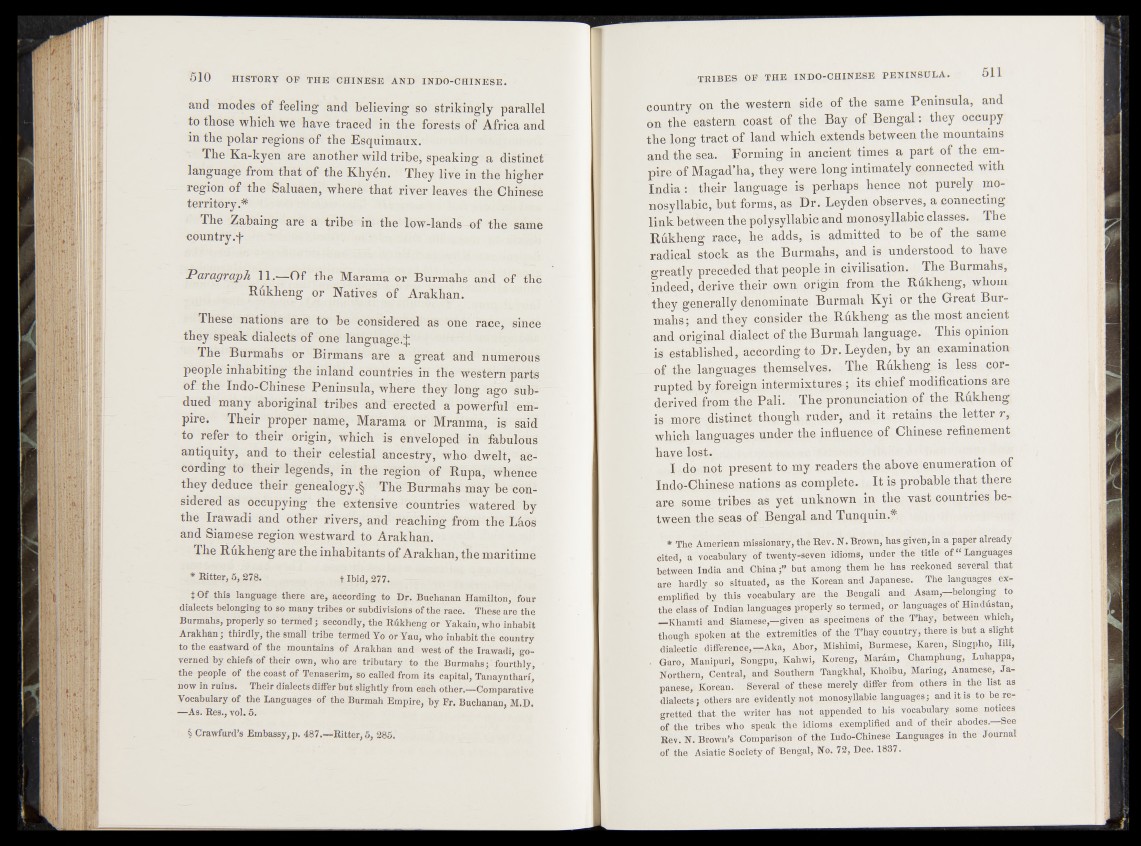
and modes of feeling and believing so strikingly parallel
to those which we have traced in the forests of Africa and
in the polar regions of the Esquimaux.
The Ka-kyen are another wild tribe, speaking a distinct
language from that of the Khyén. They live in the higher
region of the Saluaen, where that river leaves the Chinese
territory.*
The Zabaing are a tribe in- the low-lands -of the same
country.'f
Paragraph 11.—Of the Marama or Burmahs and of the
Rükheng or Natives of Arakhan.
These nations are to be considered as one race, since
they speak dialects of one language.^
The Burmahs or Birmans are a great and numerous
people inhabiting the inland countries ih the western parts
of: the Indo-Chinese Peninsula, where they long ago suP‘
dued many aboriginal tribes and erected a powerful empire.
Their proper name, Marama or Mranma, is said
to refer to their origin, which is enveloped in fabulóüs
antiquity, and to their celestial ancestry, who dwelt, according
to their legends, in thé region of Rupa, whence
they deduce their genealogy.§ The Burmahs may be considered
as occupying the extensive countries watered«-by
the Irawadi and other rivers, and reaching from the Mós
and Siamese region westward to Arakhan.
The Rükheng are the inhabitants of Arakhan, tÜe maritim e
* Ritter, 5, 278. t Ibid, 277.
tO f this language there are, according to Dr. Buchanan Hamilton, four
dialects belonging to so many tribes or subdivisions of the race. These are the
Burmahs, properly so termed; secondly, the Rükheng or Yakain,who inhabit
Arakhan; thirdly, the small tribe termed Yo or Yau, who inhabit the country
to the eastward of the mountains of Arakhan and west of the Irawadi, governed
by chiefs of their own, who are tributary to the Burmahs;'fourthly, •
the people of the coast of Tenaserim, so called from its capital, Tanaynthari,
now in ruins. Their dialeets differ but slightly from eaöh other.-—Comparative
Vocabulary of the Languages of the Burmah Empire, by Fr. Buchanan, M.D.
—As. Res., vol. 5. §
§ Crawfurd’s Embassy, p. 487.—Ritter, 5, 285.'
country on the western side of the same Peninsula, and
on the eastern coast 'of' the Bay of Bengal: they occupy
thejong tract of land which extends between the mountains
and the sea. Forming in ancient times a part of the empire
of Magad’ha, they were, long intimately connected with
India: their, language- isr-perhaps hence not purely monosyllabic,
bui-forms, as Dr. Leyden observes, a connecting
link betfveen the polysyllabic and monosyllabic classes. The
Rükheng race, he adds, is admitted be of the same
radical stock as the Burmahs, and is [understood to have
greatly preceded that people in civilisation. The Burmahs,
Jndeed, deriyé their o.wn origin from the Rükheng, whom
fjfiey. generally denominate Büijinah Kyi4 or the Great Burmahs;
and they consider the Rükheng as the most .ancient
and original dialect/lofjtb.e Burmah language. This opinion
is .establish^ according to Dr. Leyden, by an examination
of the languages themselves,.. The Rükheng is less corrupted.
by foreign intermixtures-; its;ehief modifications: are
derived-from the P a li.' The pronunciation of;the Rükheng,
is mqjpe- distinct though ruder, and the letter.
which languages under the influence refinement
have^ipst. .v < M j j | j p l P p P p H ,
X do p # present to my readers the above enumeration of
Indo-Ghinese nations as com p le te .It is. probable that there
are some tribes, as yet unknown in the, va^t, countries between
the seas of Bengal and Tunquin.*
* Thé American missionary, the Rev. $ . Brown, has givetf,,in a paper already
cited, k vocabulary of twenty-seven idioms, under fhfe title ofLanguages
between India and China ;” but’among them he has reckoned several that
are hardly so situated, as the Korean and Japanese. Th'e language# exemplified
by this vocabulary are^th^ Bengali, and Asam,^beloiiging ? to
the class of Indian languages properly so termed, q?,dangua|ësof Hindustan,
—Khamti and,Siamese,—given’’a s.«pepihiens.'öï. the Thay,* between which,
though spoken.at the extremities qf>,the».T,hay;c9pntry, there,is bnt-a slight
dialectic difference,—Aka, Abor, .Mishimi,,Burmese, Karen,> Singpho, Iili*
. Garo, Manipuri, Songpu,. Kahwi, i^aram, .C^ax^phung, Luhappa,
Northern, Central/ énd Southern Tangkhal, Khoibu, Maring, Anamese, Japanese,
Korean. Several o|-these merely differ from others in the list as
dialectsothers are evidently not^mpngsyEtabk; language^; and it is to bq regretted
that the wrifeslhas not appended Ijo^is vocabulary some.notices,
of.the tribes who speek 'ttU idioms exemplified and of their abodes.—See
Rev. N. Brown’s Comparison- öf thé Iüdo-CMnese Languages in the' Journal
of the Asiatic Society of Bengal, No. 72, Dec. 1887.